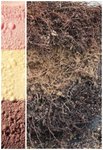Syltis
Seedling
Hi!
I am fairly new to bonsai and to this forum. I am loving the hobby though, so I'm mostly working on getting more trees to put my hands on. I recently went looking through nurseries for Norway Spruce (Picea Abies) and this was the only one I found. I wanted a more developed tree I could start styling within a couple of years, as I already own several trees in long-term training.
I liked the look of the trunk and the thickness of the foiliage. There is of course a trunk cut lurking, and I have attached two photos showing where I would hope to do this. The trunk has a bit of a bend, so I would love to go for a informal upright style. Of course the position of the cut is up for change when I get a better look at the branching (it's almost impossible to get a good overview atm due to the dense foliage). The nursery said the tree had been in the pot for years and you can see roots growing out of the pot. I know I will have to repot and maybe cut back the roots a bit, considering I am happy with the current trunk. It would also be nice to get it in a smaller/flatter pot.
I know the cut would be quite drastic, but I would love to be able to start growing a new apex soon, though I also know I need to repot. I can imagine the repot will be taxing on the tree as well. The soil it's in is also pretty garbage, so I will be repotting it in a 2:1:1 mix of akadama, kiryu and pumice.
My questions are; is the trunk cut a good idea, and if so what order would you recommend I do it in, between the cut and the repot? I am super open to suggestions.
Edit: Sorry about all the photos being vertical.
I am fairly new to bonsai and to this forum. I am loving the hobby though, so I'm mostly working on getting more trees to put my hands on. I recently went looking through nurseries for Norway Spruce (Picea Abies) and this was the only one I found. I wanted a more developed tree I could start styling within a couple of years, as I already own several trees in long-term training.
I liked the look of the trunk and the thickness of the foiliage. There is of course a trunk cut lurking, and I have attached two photos showing where I would hope to do this. The trunk has a bit of a bend, so I would love to go for a informal upright style. Of course the position of the cut is up for change when I get a better look at the branching (it's almost impossible to get a good overview atm due to the dense foliage). The nursery said the tree had been in the pot for years and you can see roots growing out of the pot. I know I will have to repot and maybe cut back the roots a bit, considering I am happy with the current trunk. It would also be nice to get it in a smaller/flatter pot.
I know the cut would be quite drastic, but I would love to be able to start growing a new apex soon, though I also know I need to repot. I can imagine the repot will be taxing on the tree as well. The soil it's in is also pretty garbage, so I will be repotting it in a 2:1:1 mix of akadama, kiryu and pumice.
My questions are; is the trunk cut a good idea, and if so what order would you recommend I do it in, between the cut and the repot? I am super open to suggestions.
Edit: Sorry about all the photos being vertical.
Attachments
-
 20200219_082829.jpg151.2 KB · Views: 133
20200219_082829.jpg151.2 KB · Views: 133 -
 20200219_082834.jpg307.4 KB · Views: 131
20200219_082834.jpg307.4 KB · Views: 131 -
 20200219_082837.jpg281.7 KB · Views: 114
20200219_082837.jpg281.7 KB · Views: 114 -
 20200219_082849.jpg239.5 KB · Views: 114
20200219_082849.jpg239.5 KB · Views: 114 -
 20200219_082912.jpg177.2 KB · Views: 109
20200219_082912.jpg177.2 KB · Views: 109 -
 20200219_082941.jpg262.9 KB · Views: 95
20200219_082941.jpg262.9 KB · Views: 95 -
 rootsgrowing.jpg155.5 KB · Views: 90
rootsgrowing.jpg155.5 KB · Views: 90 -
 trunkcut.jpg175.8 KB · Views: 87
trunkcut.jpg175.8 KB · Views: 87 -
 trunkcut2.jpg150.4 KB · Views: 100
trunkcut2.jpg150.4 KB · Views: 100







